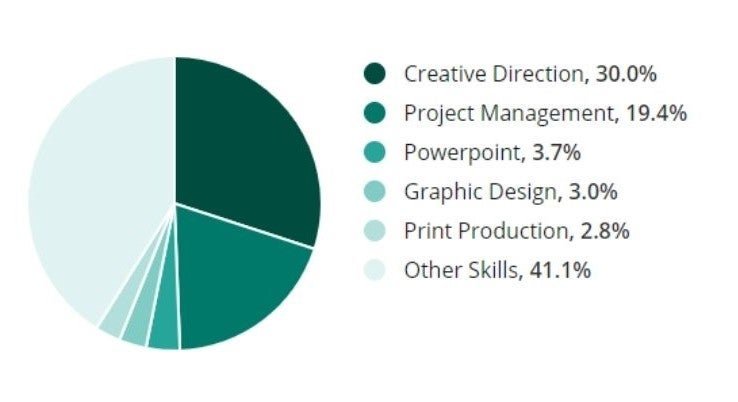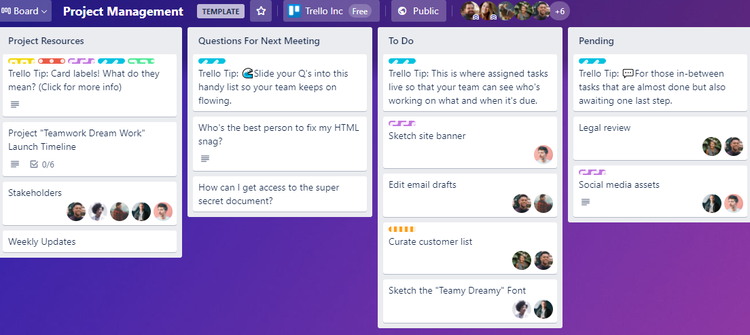Creative project management helps ensure that your client or company reaches its digital marketing goals. A project manager may oversee entire campaigns or focus on specific tasks.
Regardless of the project, team leaders must overcome challenges and deliver on expectations. Whether you're in a project management role now or looking for such a position, you can use this guide to perfect your techniques.
Overview: What is creative project management?
Creative project management is the process of managing creative teams while moving projects toward completion. Projects typically support marketing, public relations, sales, and customer service objectives. Your on-site or virtual staff may include:
- Graphic designers
- Artists
- Copywriters
- Search engine optimization (SEO) specialists
- User experience (UX) designers
- Web developers
- Content marketing writers
- Branding specialists
- Photographers
- Social media assistants
- Editors
Business owners may take on the role of a creative manager. Or entrepreneurs may outsource marketing to a creative agency for project management. Anytime you plan a campaign, advertisement, email, video, or blog post and use artistic services, you're leading a creative team.
What does a creative project manager do?
A creative project manager communicates and collaborates with clients, stakeholders, and creative teams to brainstorm, plan, and deliver projects. The role requires excellent communication, attention to detail, and time management abilities.
Creative project manager jobs may be in-house, where your projects focus on one brand and audience, or project managers can work at a creative agency with many clients.
Team leaders require project management skills and tools that help them manage:
- Client expectations
- Project scope and cost
- An assorted team with various talents
- Creative workflows
- Project and individual deadlines
- External stakeholders or vendors

Creative project managers need a diverse skill set that includes management and creative talents. Image source: Author
Challenges of creative project management
Project management responsibilities are diverse, meaning the right person for the job must have talents in many areas. It's different from your team members' roles since they specialize in one or more creative activities.
A project leader needs to be knowledgeable about different project components while adhering to a strict schedule and juggling conversations with executives and creatives. With numerous obligations, project managers face several challenges.
Setting and meeting expectations
A project manager must guide expectations for the project owner, external stakeholders, agency owners, and creatives. Once expectations are set, managers must deliver the experiences that each individual wants, which is tricky considering the number of different personalities they will encounter.
Overcoming communication challenges
Creative project management training often dives into communication strategies. As a project manager, you'll face hurdles when connecting with multiple people, including:
- Language barriers affecting project timelines, editing, and the approval process
- Time zone differences making it hard to get everyone on the same page
- Industry jargon that may differ from the terms creatives or other stakeholders use
Managing creatives and their tools
Each individual you work with has a different skill set. Although we lump everyone under the category of "creatives," in reality, a web developer is different from a copywriter.
As a project manager, you're expected to understand your team members and their talents while having a basic knowledge of various applications, such as:
- Project management software
- PowerPoint or slideshow applications
- Graphic design tools
- Video editing software
- Print production methods
- Content management systems (CMS)
- Customer relationship management (CRM) programs
3 best practices when managing creatives
Anytime you employ a team of people with distinct skill sets, you can run into problems that reduce productivity and affect deadlines. While some leaders suggest managing creatives is difficult, the bottom line is that you can make it easier or harder on yourself and others as a project leader.
Give teams everything they need to complete projects in a productive manner using creative project management best practices.
1. Centralize the creative project management process
If you're managing more than one person or project, email won't cut it because it's unwieldy and hard to follow. Your creative workflow involves many steps, and you can quickly lose track of what's going on and where.
Avoid problems by finding an application that's easy to use for creatives with various talents, encourages collaboration when needed, and shows the project status as it moves through completion. Trello, Asana, and monday.com are popular platforms for project management.
Each tool supports:
- Project planning: Access planning documents, team rosters, individual strengths, brand assets, and editorial calendars.
- Assignment delegation: Track workloads and team availability while making it easy to tag creatives and delegate projects.
- Creative asset development: Boost productivity by integrating applications, such as Google Drive, into your project management software.
- Status updates: Give creatives a place to ask questions or provide updates relating to digital projects.
- Revision method: Save time by alerting creatives to a revision request using project management software instead of an email.
- Approval process: Make the chain of command clear so each individual knows whom to tag once they're finished.

Use Trello to manage your project workflow and keep resources accessible. Image source: Author
2. Balance creativity with organization
As mentioned above, creatives get a bad rap for being difficult to work with. The creative process varies by individual, and many team members work independently or in small groups.
Creatives may be the best at what they do but may not understand what happens behind the scenes at your business or agency. Project management techniques must include ways to balance the creative process with timely project completion.
If you run into repeated problems with employees or contractors, first review your communications for clarity. Next, consider individual circumstances. Ask yourself:
- Did you provide guidance, answer questions, and offer self-help tools, such as brand guidelines?
- Are there any apparent language, technology, or other communication barriers?
- Could you adjust workflow or deadlines for a better fit?
- Are you selecting people with the right skills for the job?
Once in a while, you may need to cut someone loose. People who consistently underperform or cause delays in your projects affect all team members. Sure, your role requires empathy and people skills, but you're also getting paid for project organization and workflow management.
3. Develop frameworks for creative operations
Project managers must provide creative direction, feedback, and deadlines. In short, you want to give each team member what they need to complete their job.
Start by assessing your project management methods. Create several documents to support creatives and manage projects. Put guidelines in your project management system so they’re accessible.
Project managers may develop blueprints for:
- Project intake: Give project owners, executives, or clients a questionnaire to get details about project scope, timelines, and expected outcomes.
- Project assignments: Be transparent about assigning tasks and how creatives can relay information about their availability.
- Standard operating procedures (SOPs): Anything you or your team does more than once should be outlined in your SOP, such as invoicing policies.
- Brand style guides: Provide specifics about your brand or your client's brand, including voice, tone, and style. Add image specifications or other asset-related details.
- Creative briefs: Develop task-specific outlines that list milestones, deadlines, objectives, and expectations.
- Brand assets: Keep a file of frequently used brand documents, such as logos and other media, and be sure they’re sized accordingly for various platforms.
Project management for creatives: Take the lead
Creative project management is a fun role because it incorporates creativity and organizational skills. You're also communicating and collaborating with people from all backgrounds and with different skill sets, making it crucial to be flexible yet firm. Standardize what you can to reduce potential problems while giving creative teams everything they need to get the job done.
Our Small Business Expert
We're firm believers in the Golden Rule, which is why editorial opinions are ours alone and have not been previously reviewed, approved, or endorsed by included advertisers. The Ascent does not cover all offers on the market. Editorial content from The Ascent is separate from The Motley Fool editorial content and is created by a different analyst team.